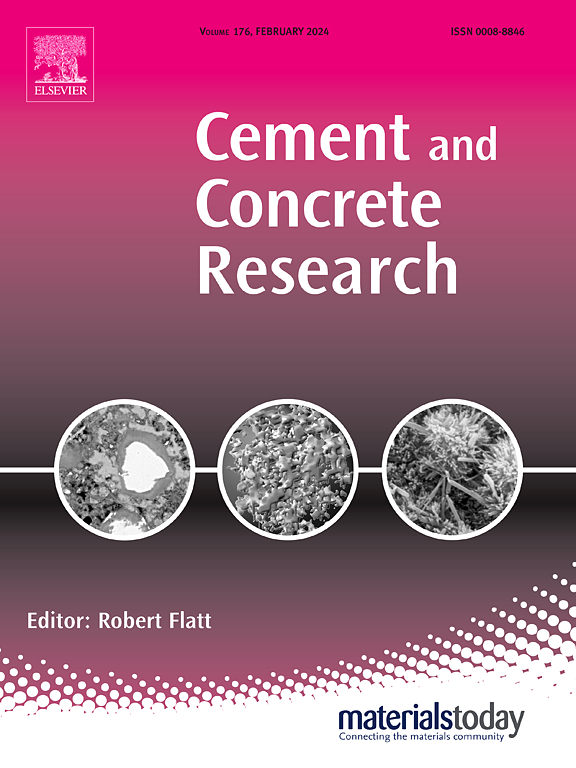水合硅酸钙凝胶孔隙中离子溶液的冻结行为
IF 10.9
1区 工程技术
Q1 CONSTRUCTION & BUILDING TECHNOLOGY
引用次数: 0
摘要
盐冻损伤是影响混凝土结构耐久性的关键问题,但目前对胶凝材料凝胶孔隙中离子溶液的冻结行为和微观机制尚不清楚,不利于从下到上优化抗寒混凝土设计。本研究采用分子动力学(MD)模拟方法,分别建立了含NaCl、Na2SO4和水溶液的饱和水合硅酸钙(C-S-H)凝胶孔隙模型。研究了离子溶液在230 K时在凝胶孔内的冻结行为。模式冻结过程具有明显的周期性。Na+和Cl−延缓了孔隙水的冻结,而SO42−在冻结锋附近积累,显著阻碍了冻结进程。在NaCl模型中,冻结形成了两种类型的纳米盐水袋。这项工作为胶凝材料中的盐冻结提供了新的分子见解,并在分子尺度上为耐寒混凝土的设计提供了信息。本文章由计算机程序翻译,如有差异,请以英文原文为准。

Freezing behavior of ionic solutions within calcium silicate hydrate gel pores
Salt-frost damage is a crucial issue affecting the durability of concrete structures, however, the freezing behavior and micro-mechanisms of ionic solutions within cementitious material gel pores remain unclear, which is not conducive to optimizing cold-resistant concrete design from the bottom up. In this study, the models of saturated calcium silicate hydrate (C-S-H) gel pores containing NaCl, Na2SO4, and aqueous solution, respectively, were constructed by molecular dynamics (MD) simulation. We investigated the freezing behavior of ionic solutions within the gel pores at 230 K. The freezing process of models exhibited a distinct periodic pattern. Na+ and Cl− delayed the freezing of pore water, while accumulated near the freezing front, significantly hindering freezing progression. The freezing resulted in two types of nano brine pockets in the NaCl model. This work provides new molecular insights into salt freezing in cementitious materials and informs the design of cold-resistant concrete at the molecular scale.
求助全文
通过发布文献求助,成功后即可免费获取论文全文。
去求助
来源期刊

Cement and Concrete Research
工程技术-材料科学:综合
CiteScore
20.90
自引率
12.30%
发文量
318
审稿时长
53 days
期刊介绍:
Cement and Concrete Research is dedicated to publishing top-notch research on the materials science and engineering of cement, cement composites, mortars, concrete, and related materials incorporating cement or other mineral binders. The journal prioritizes reporting significant findings in research on the properties and performance of cementitious materials. It also covers novel experimental techniques, the latest analytical and modeling methods, examination and diagnosis of actual cement and concrete structures, and the exploration of potential improvements in materials.
 求助内容:
求助内容: 应助结果提醒方式:
应助结果提醒方式:


